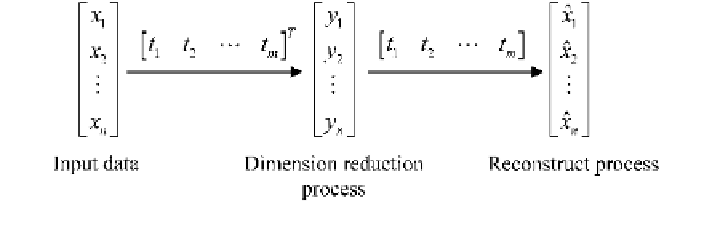Environmental Engineering Reference
In-Depth Information
Fig. 9.2 The main steps of PCA
where a corresponds to a confidence interval of 95 % with the assumption of a
normal distribution. Outlier statistics indicates that the prediction errors overpass
the limits; in healthy conditions, the vibration features should lie in the hyperplane,
and the outlier statistics value of the data should remain at the same level as for
the reference data. On the contrary, if damage occurs, the features should deviate
from the original hyperplane, and the outlier statistics should increase signifi-
cantly. A geometric interpretation about above method in a two-dimensional case
was given by Yan [
23
].
9.2.3 Numerical Example
9.2.3.1 The Wind Turbine Blade Model and Structural Dynamic
Response Simulation
To test the validity of the proposed damage detection and variability rejection
methods, in this section, some numerical results obtained with the proposed methods
on a simulated blade are provided. The FE model of the blade was created according
to a real, small blade with a length of 2.05 m, which is assembled in a small wind
turbine with a power of approximately 1 kW. The blade was modeled as a cantilever
beamwith finite element analysis software ANSYS using shell63 elements, which is
available for use in stress stiffening and large deflection. The damage is simulated as
the reduction in the stiffness of some elements. More precisely, the damaged ele-
ments in three levels, whose location is 0.5 m from the end, are modeled as a
reduction of the material elastic modulus by 5, 10, 20, and 30 %. In addition,
Rayleigh damping, whose coefficients are a = 1.73 and b = 0.00015, was applied
to the finite element model during the dynamic simulation. Figure
9.3
shows the FE
model of the blade.
Simulation scenarios for both the undamaged cases, which serve as the refer-
ence signal for the subsequent damage detection, and the damaged cases are
considered. For each undamaged and damaged case, different rotational speeds
about the global Cartesian Y axes, from x = 1 rad/s to 40 rad/s with an increment

